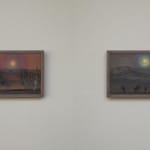Nakamura Masayoshi (1924−1977)
Mountains (Set of two)
Color on paper, framed (0F)
With a label signed by the artist (each)
Seal: Gi (each)
13.9 x 17.9 cm each
16 x 20 cm each (overall)
Further images
Although Yama (mountain) and Yamayama (mountains) were not intended to be a pair initially, there is a sense of consistency in between that engage us to view the two as connected. Both paintings overlook a range of mountains, above which a sun or a moon appears perfectly round and shining. The crimson Yama set the mountains against the rose madder sunset, whereas the mountains in Yamayama are backlit by the full moon in the sky. Thus, it is not odd at all to view the two as a pair of the sun and the moon. The white standing woods in Yama indicate it is snowy winter, and the flow of seasons from deep autumn in Yamayama to winter in Yama can be experienced. Just as there always seem to exist certain “something” beyond the subjects in Nakamura Masayoshi’s most recognized maiko portrait and self-portrait series, the mountains in these two paintings as well contain the similar mysterious atmosphere. These mountains certainly surpass the genre of landscape painting in this sense.
Nakamura Masayoshi (nihonga painter; 1924−1977)
Aichi-born nihonga painter. Studied under Nakamura Gakuryo. Active in Nitten; later left and worked independently. Exhibited at Gendai bijutsu-ten, Nihon kokusai bijutsu-ten, and solo shows, while producing dramas, films and many others. Founded Hitohito-kai and participated in various activities to attempt a reformation of Japan’s art world. Recognized as a “maverick genius.”
Nakamura Masayoshi (nihonga painter; 1924−1977)
Aichi-born nihonga painter. Studied under Nakamura Gakuryo. Active in Nitten; later left and worked independently. Exhibited at Gendai bijutsu-ten, Nihon kokusai bijutsu-ten, and solo shows, while producing dramas, films and many others. Founded Hitohito-kai and participated in various activities to attempt a reformation of Japan’s art world. Recognized as a “maverick genius.”









